June 16, 2025 | 15:20 GMT +7
June 16, 2025 | 15:20 GMT +7
Hotline: 0913.378.918
June 16, 2025 | 15:20 GMT +7
Hotline: 0913.378.918
According to Mr. Doan Quoc Tuan, the leader of the Dong Trung community agricultural extension group in Thanh Thuy district, Phu Tho province, his land consists of 258 hectares of spring rice, which includes 156 hectares of seasonal rice and 40 hectares of ratoon rice.
The majority of the acreage is concentrated in the uneven fields, where farmers hand harvest spring rice, while the rest of the flat region is used for machine seeding and harvesting.
Since the implementation of ratoon rice cultivation, there has been a reduction in the use of chemical fertilizers and pesticides. As a result, the environment has become cleaner, providing a more pleasant atmosphere for children and locals to enjoy strolling across the fields.
It is unlike previous times when farmers excessively utilized chemical pesticides. After each period of pesticide application, individuals refrain from coming into contact with the field. Additionally, residents living near the fields are required to close their doors. Planting ratoon rice attracts useful creatures and insects, such as frogs, snails, crabs, etc., back to the fields.
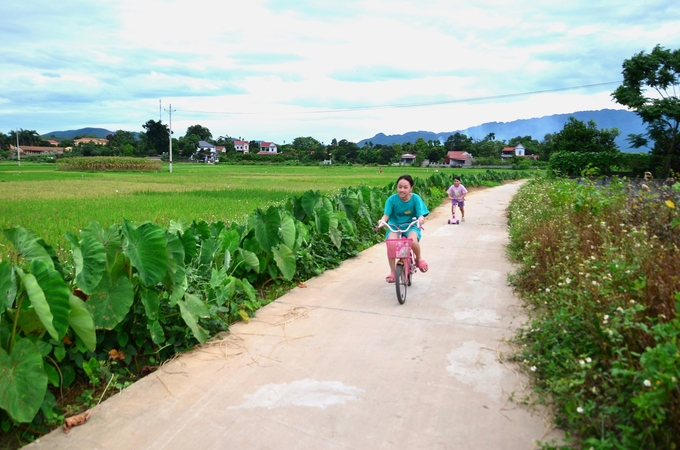
The road around the rice fields was reborn as a place for people to walk and exercise. Photo: Duong Dinh Tuong.
Initially, there was uncertainty regarding the superior quality of rice from ratoon rice compared to transplanted rice. However, when people had the opportunity to try it, the superiority became clear. Despite being a hybrid variety, this rice is more flavorful, sticky, and aromatic compared to some rice types derived from purebred species.
As a result, most households prefer to save it for their own consumption. In addition to the current safety measures in place, Dong Trung commune intends to provide guidance to its citizens on implementing VietGAP and organic standards for rice cultivation. This initiative aims to increase the value of the rice produced and assure both environmental and health safety.
Pham Duc Ngoc, an agricultural extension worker in zone 2 of Dong Trung commune, informed me that farmers previously faced difficulties with seasonal transplanting, resulting in yields of only 70-80kg per rod.
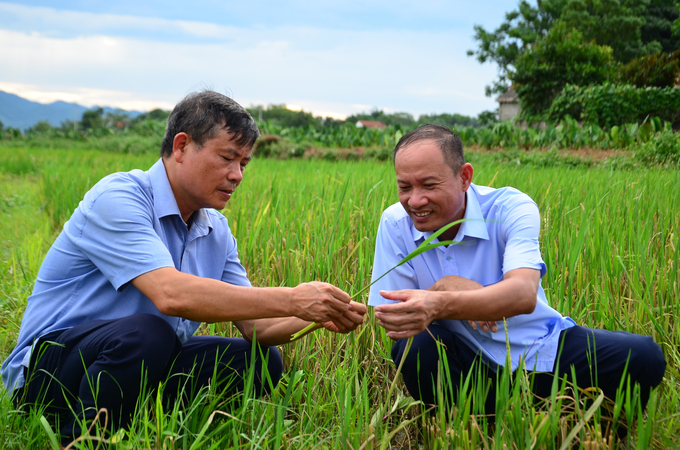
Checking ratoon rice. Photo: Duong Dinh Tuong.
As a solution, they transitioned to cultivating ratoon rice due to its lower investment requirements while still ensuring a harvest. The agricultural extension teams at the district and commune level also conducted training sessions for farmers on high-yield ratoon rice production.
Zone 2 contains a total of 145 families, and the majority of these households practice the cultivation of spring rice as ratoon rice. This is particularly true now that the fields have been consolidated into larger and more manageable plots, which simplifies the maintenance process. Due to the scarcity of concrete canals, irrigation in this area poses challenges, resulting in farmers' lack of enthusiasm about rice transplantation in recent years.
Furthermore, the fields are located in close proximity to the settlement, making them susceptible to damage from mice that would feed on the delicate and newly transplanted rice plants. However, when cultivating ratoon rice, the occurrence of damage caused by mice and pests is significantly reduced. As a result, there is no necessity to utilize pesticides or set traps. Instead, it suffices to administer a few kilograms of nitrogen fertilizer per rod and patiently await the harvest.
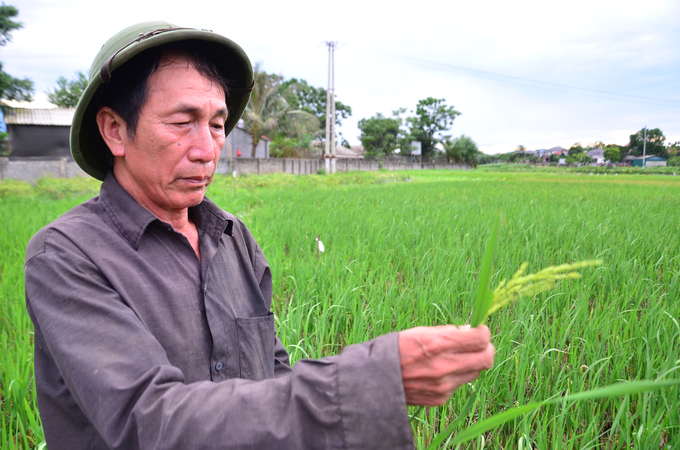
In only about 15 days, the ratoon rice plants bloomed. Photo: Duong Dinh Tuong.
Due to its efficacy, we opted for manual harvesting rather than employing machinery for the collection of ratoon rice," Mr. Ngoc disclosed.
The Thanh Thuy District, located in Phu Tho Province, cultivates an annual area of rice ranging from 2,800 to 2,900 hectares, with approximately 600 to 700 hectares dedicated to ratoon rice. The variation in area is attributed to natural circumstances; years characterized by abundant rainfall and elevated water levels facilitate expansion, whilst years marked by scarce rainfall and reduced water levels present greater difficulties.
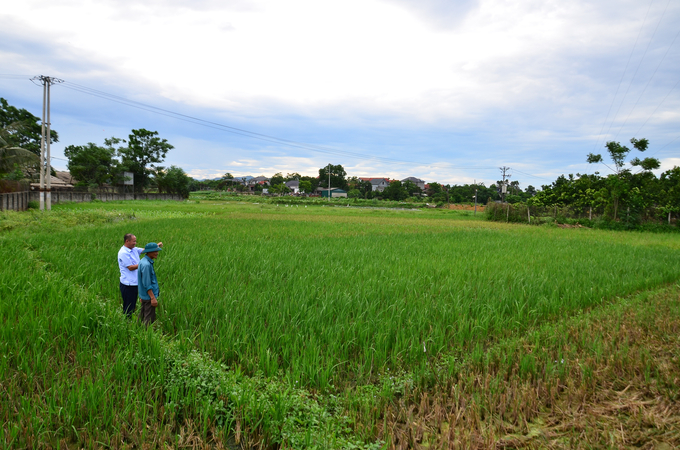
Well-regenerated rice fields can yield more than 1 quintal per rod. Photo: Duong Dinh Tuong.
Ratoon rice has distinct advantages over the main crop of transplanted rice, as it circumvents the challenges posed by pests, rainstorms, and low yields. This alternative method eliminates the need for plowing and pesticide treatment, while also requiring minimal or no fertilizer, depending on the location.
According to Mr. Tran Duy Thau, the Plant Protection Station's leader in Thanh Thuy District, the practice of cultivating ratoon rice is derived from the farmers' firsthand knowledge.
Initially, only a limited number of households would enclose their harvested rice fields to confine ducks within, so preventing cows and buffaloes from entering. This, in turn, facilitated the growth of fresh ratoon rice shoots from the remaining rice stubble. Upon witnessing the advantages of ratoon rice, other individuals began to emulate the practice," Mr. Thau stated.
Bao Yen became the pioneer commune in Thanh Thuy District to adopt ratoon rice cultivation approximately two decades ago, in line with Phu Tho Province's initiative to provide financial support for hybrid rice seeds in order to enhance agricultural output. In the past, farmers would raise ducks in the ratoon rice fields.
When the rice became ready, the ducks would selectively consume the ears near the base, while the higher ears would be manually plucked, transported back home, and then processed to separate the grains. Upon the spontaneous development of ratoon rice by the farmers, agricultural officials conducted an inspection and subsequently instructed its expansion to neighboring communes.
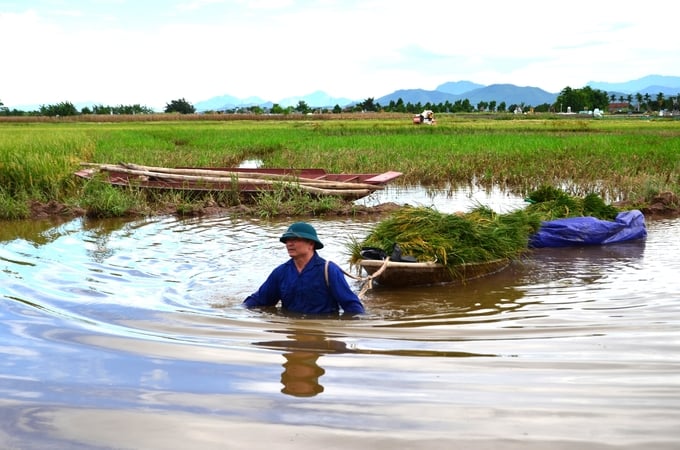
Harvesting rice in the low-lying fields. Photo: Duong Dinh Tuong.
Ratoon rice cultivation is limited to areas with special circumstances, including low-lying ground, the use of hybrid cultivars, and manual harvesting. In the past, farmers preferred the Nhi Uu No.7 variety. However, they have now shifted to using varieties such as Thai Xuyen 111 and Thuy Huong 308 due to their ability to produce rice grains of superior quality and their great regenerative powers.
The growing period for ratoon rice is rapid, with a harvest time of approximately 1.5 months. The mean productivity is 50-60 kg per rod, whereas favorable regions can achieve yields of 80-90 kg per rod, or even more.
Nevertheless, due to the extensive utilization of harvesting equipment, these machines trim the stubble very closely and compress it, resulting in harm to the growth nodes and hindering the rice's ability to regenerate. In addition, the growth of aquaculture poses a significant challenge to ratoon rice agriculture.
Translated by Linh Linh
/2025/06/12/3721-2-202745_83.jpg)
(VAN) TH made an impression at Seoul Food 2025 with its line of natural beverages, paving the way for Vietnamese food products to enter the South Korean market.

(VAN) Soc Trang's success in rice exports stems from a strategy of developing fragrant and specialty rice cultivation areas and standardizing production toward low-emission practices.
/2025/06/11/1311-5-120811_839.jpg)
(VAN) The pig farming industry is facing the challenge of comprehensive restructuring to meet requirements for quality, safety, traceability, and market expansion both domestically and for export.

(VAN) Vietnam considers participating in ALGROALBA in order to expand agricultural production, coordinate the assessment and effective exploitation potential land.
/2025/06/05/5314-1-184727_407.jpg)
(VAN) From seemingly worthless fish scales and skin, enzymes and lactic ferments can transform by-products into peptides, opening a sustainable, effective business direction and elevating Vietnamese seafood.

(VAN) TTC AgriS and IFC signed a strategic partnership to develop a sustainable agricultural value chain, aiming to achieve the Net Zero target by 2035.

(VAN) Seafood by-products are opening a new path, combining green growth and technological innovation to enhance the industry's value.